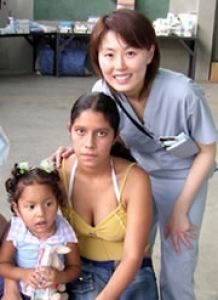First check up by First Birthday
The Canadian Dental Association and the American Academy of Pediatric Dentistry recommends that every child visit the dentist by the child’s first birthday. Research has shown that children who waited past their first birthday and did not see a dentist until age two or three “were more likely to have subsequent preventive, restorative and emergency visits. A child should be seen by a pediatric dentist, no matter how young that child is, No child is too young for good dental health.
Good mother’s oral health equals good baby’s oral health
Babies can “catch” cavities from their caregivers, the most likely source being their mothers. Cavity-causing bacteria known as Streptococcus mutans can be passed on from mothers to infants even before teeth erupt.
Yes to Water, No to Milk
Baby should be sleeping with a bottle of water, not a bottle of sugary liquids such as milk, formula or fruit juice. Bacteria is good at converting sugar to acids which decay teeth, especially during sleep when saliva flow is the lowest.
Sugars are sugars
Whether natural or processed, cavity-causing bacteria like it just as much and can use it to make cavities. Watch for hidden sugars in natural and processed foods. Munching on blueberries for 2 hours is worse for your teeth than gobbling up a chocolate bar in less than 5 minutes. Before you switch to an all chocolate diet, please remember, it is the high frequency eating / snacking / gracing which increases cavities, not the type of food.
The more the merrier? No!
Brushing your child’s teeth with the right amount of fluoride helps prevent cavities. Careful supervision is encouraged and don’t let them swallow the toothpaste. For children under 2-years-old, use a smear of fluoridated toothpaste. For those 2 to 5-years-old, a small pea-sized amount of fluoridated toothpaste on the brush is recommended.
Goodbye Soother
Sucking on a thumb, finger, or pacifier is normal for infants and young children; most children stop on their own. If a child does not stop by herself, the habit should be discouraged after age three.
5 minutes makes a big difference
A knocked out adult tooth can only survive outside the bone socket for less than 10 minutes. If your children knock out an adult tooth, find the tooth, hold the tooth by the crown, rinse it and try to insert the tooth back to where it belongs. It gives the tooth best chance to survive.
I can do it myself
Children can brush their own teeth when they can tie their own shoes. Both tasks require about the same manual dexterity. Until then, help your child brush after breakfast and before bed.
Soften the impact
A mouthguard not only protects the teeth but may reduce the force that can cause concussions, neck injuries and jaw fractures. Children should wear a mouth protector whenever she is in an activity with a risk of falls, collisions or contact with hard surfaces or equipment. This includes sports such as football, baseball, basketball, soccer, hockey, wrestling and gymnastics, as well as leisure activities such as skateboarding, skating and bicycling.
Why does my gum bleed?
Gum disease (also called periodontal disease or gingivitis) occurs more often as children get older, especially when they reach puberty and they undergo hormonal changes. It affects six out of ten teenagers. To prevent red, swollen gums, bleeding gums and bad breath, brush and floss and have regular dental visits.



